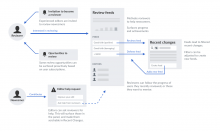This ticket captures design ideas to help reviewers to find good-faith editors and encourage them to help newcomers in a constructive way. This is the goal of the Edit Review Improvements project.
An overview of the areas considered is captured in a diagram below, sub-tickets will be created to capture the different ideas in more detail.
Areas to explore
- T137814: Review feeds. A central place that provides an overview of the user review activity and encourages constructive follow-up actions.
- T138935: Contribution filtering. Filters for contributions (on recent changes or dedicated pages) need to be improved to target the good-faith criteria and provide the flexibility needed to define custom review feeds.
- T142785 considers extending the current Recent Changes page to better support finding good-faith newcomers.
- T138808: Invite to become a reviewer. Experienced editors can help newcomers, we want to let them know they are invited to do so.
- T138815: Editors asking for help. Allowing newcomers the possibility of asking for help as soon as possible can help to surface their good intentions and make the interaction with reviewers more fluent.
- T139064 Entry points and integrations. Identify existing areas related to the reviewing activity to connect the proposed solutions with them.
- T138939 Reviewing contributions. Allow users to view the changes of a feed, evaluate them and perform follow-up actions. Encouraging constructive behaviour while keeping efficiency is the main balance to achieve. This is not the main area of exploration, but it is interesting to check how of the previos concepts can support the reviewing activity.
Prototype
To view how those ideas fit together you can view this video walkthrough.
The video is based on a prototype you can interact with, but note that it only supports the interactions needed to illustrate a few scenarios.
Plans to research these ideas captured at T140161: Page Curation user workflows and Edit Review prototype concept validation
